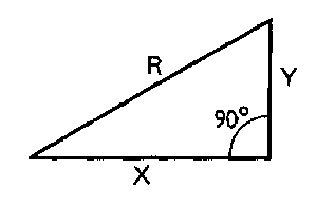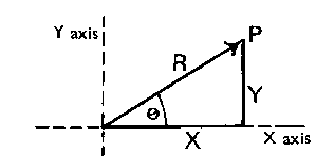|
INSTRUCTION LEAFLET
for the
FEARNS TRIGONOMETRY CALCULATOR |
The Fearns Trigonometry Calculator consists of; a main dial;
a smaller top dial and a cursor to facilitate interpolating between
graduations.
|
| Y scale - This Is the outer red scale on the main
dial. It is a simple log scale with a range (including the overlap portion)
from .001 to 100. |
| R or X scale This is the black scale on the
periphery of the top dial. It also is a simple log scale, and has a range
from .1 to 100. It is used for values of R or values of X. If the
calculation in question involves values of both R and X, then use this
scale for the R value and the Y scale for the X value. |
Angle scale There are, in addition to the above,
four angle scales, two of which show in each of the two windows. Each scale
is calibrated in degrees and minutes, and the spacing of the graduations on
each respectivelyis proportional to log.cosine
a; log.sine
a; log.cotangent
a ;and log.tangent
a , as indicated on the top dial, and where
a is the angle inquestion. For ease of reference, the window on the
left-hand side of the top dial (when the latter is the correct way up) will
be referred to as the left-hand window, and the other as the right hand
window. Thus, the cosine and sine graduations are in the left-hand window,
and the cotan.and tan. graduations in the Right-hand window.
|
| Nomenclature The following symbols are used
throughout: |
 |
X = Base of triangle
Y = Vertical height of triangle
R = Hypotenuse of triangle
Note: The angle between X and Y is always 90° ,
and the other two angles are always the ones concerned in the calculations. |
|
Trigonometrical Functions
|
To find the Cosine of an angle set the upper
graduation on the left-hand window (i.e. the one marked Cosine) to the
angle, and read off the cosine on scale Y opposite the black arrow.
|
| To find the Sine, Tangent, or Cotangent of an angle
proceed exactly as above, but setting the appropriate graduation to the
angle. (e.g. If tangent is required, set the graduation marked Tan. to the
angle.) |
| |
| EXAMPLES |
Find the cosine of 75° 30.
Set the Cosine graduation to 75° 30 and read
the
required value of .250 opposite black arrow. |
| |
Find the tangent of 19°.
Proceed as before, but set the Tan. graduation to the
angle.
Answer .345 |
Note: Use the values on the outer portion of the Y scale,
for Sines and Tangents if the angle is below 6°,
and for Cotangents and Cosines if the angle is over 84°.
|
| EXAMPLE |
Find the Cotangent of 86° 10'.
Answer (on outer scale) .0670
|
To find an angle when its cosine, sine, tangent, or
cotangent is known use the same scales as before but reverse the
procedure. i.e. Set the black arrow to the known value of the function and
read off the angle in the window opposite the appropriate graduation.
|
| EXAMPLE |
Find the angle whose sine is .380
Set the black arrow to .380 on scale Y, and read the answer
22° 20 in the left-hand window opposite the
Sine
graduation. |
To find a function of an angle, given another function of
the same angle set the black arrow to the value of the known function
on scale Y and read the angle in the appropriate window. Re-set same angle
for the required function, and read answer opposite black arrow.
|
| EXAMPLE |
Find the value of Sin (Tan-1 .550).
Set black arrow to .550 and read angle opposite Tan graduation, i.e. 28°
50. Then set Sine graduation to 28° 50
and read the required answer .480 opposite black arrow.
|
|
Solution of Right-Angled Triangles
|
| General The procedure for solving any right-angled
triangle is very simple. Normally in any given problem there are two known
values and one unknown or required value. Procedure is to set the calculator
to the known values and read off the required value, taking care to use the
correct window and scales, thus: |
| (a) It two sides are known set one side against the
other on the outer scales, and read off the angles in the appropriate
window. |
| (b) If one side and one angle are known set the
appropriate graduation to the known angle; set the cursor over the known
side on the appropriate outer scale and read off the value of the other side
on the adjacent outer scale. |
(c) If two sides are known and the other side is required
first determine the angles as in (a) and then determine the other side as
in (b).
|
Note: As will be observed from the diagrams on the top dial,
if the hypotenuse R is involved in the calculation, the left-hand window
only is used for angle setting or reading, and if the base X and
perpendicular Y only are involved use the right-hand window.
|
| EXAMPLES |
|
| for (a) |
If X equals 2 and Y equals 5, find the angles.
Set 2 against 5 on the outer scales and read angles in right-hand window.
Answer 68° - 10' and 21°
- 50'. |
| for (b) |
If R equals 7 and the included angle between R and Y equals 70°
find Y.
Set the graduation on the top of the left-hand window to 20°,
and set the cursor over 7 on the black outer scale.
Read off the answer Y equals 2.39
|
|
Using the Trigonometry Calculator as a Circular Slide
Rule
for Multiplication and Division
|
As the Y scale and the R/X scales are simple
logarithmic scales it will be readily appreciated that they can be used for
multiplication and division as with a normal slide rule. Procedure is
exactly the same as with a straight slide rule, the only difference being
that the scales are circular.
|
|
Vectors. Cartesian and Polar Co-ordinates
|
 |
The vector R or She point P in Co-ordinate
Geometry is
expressed in Polar Co-ordinates as R = R,q
where the length R
is the modulus, radius vector, or numerical value, and
q is the
argument or vectorial angle. |
The same vector or point can also be expressed
in its Cartesian Co-ordinates X and Y, and the following relationship
between the two co-ordinate systems exists.
|
| X = R. cos
q |
Y = R. sin
q |
|
q = tan -1 (Y/X) |
R =
Φ(X2 + Y2)
|
|
Conversions between Cartesian and Polar Co-ordinates
|
(a) To convert Cartesian Co-ordinates X and
V to Polar Co-ordinates R and
q.
First set X to V on outer scales and read
q in right-hand window against Tan, graduation.
Then set
q against sine graduation in left-hand window and
against value of Y on outer scale read value of R.
|
| EXAMPLE |
Find the Polar Co-ordinates of 4 and 3.
Set 4 on X scale to 3 on Y scale and read 37°
against Tan.
graduation in right-hand window. Set 37° against
Sine
graduation in left-hand window and against 3 on Y read
5 on R scale.
Answer 4, 3 = 5, 37°
|
(b) To convert Polar Co-ordinates R &
q to Cartesian Co-ordinates X and Y
First set
q against Cosine graduation in left-hand window and
against value of R on R scale read value of X on the outer red scale (using
the Y scale for X values in this instance).
Then set
q against Tan. in the right-hand window and against X
on the X scale read value of Y on the Y scale.
|
| EXAMPLE |
Find the Cartesian (or Rectangular
co-ordinates) of 2, 60°.
Set 60° against Cosine graduation in left-hand
window and
against 2 on R scale read X = 1.0
Set 60° against Tan, graduation in right-hand
window and
against 1.0 on X scale read Y= 1.73
Answers 2,60° = 1, 1.73
|
|
Complex Numbers
|
| A complex number is represented similarly by a
point P on an Argand Diagram in which the real part X and the imaginary part
Y of the complex number are stated as: |
| R = X+jY |
| = /R/[ cos
q + j. sin
q ] |
= /R/ ejq
|
The real part and imaginary part of the complex
number representing a vector R in the diagram can be determined as in (a)
above. Conversely the numerical value or modulus R, and the argument or
vectorial angle
q of the complex number X + j Y can be determined as
in (b) above.
|
|
Electrical A.C. Power Calculations
|
The Electrical Engineer will readily observe
that the calculator can be used for solving A.C. power calculations in a
circuit by using the following relationships:
|
R = Total Power in volt-amperes
X = Active Power in watts
Y = Reactive Power in reactive volt-amperes
cos = Power Factor = X/R |
| EXAMPLE |
Find the power factor (and angle) of a
load which takes 15 volt-amperes and 12 watts. (i.e. We know R and X and
require to know cos
q and
q, therefore use left-hand window and use the Y scale
for X.)
Set 15 on R scale to 12 on Y scale (representing X) and read off Power
Factor, cos
q = 0.8 on Y scale opposite black arrow.
In left-hand window read off = 37° opposite
cosine graduation.
|
|
FEARNS CALCULATORS
Atlas Works, West View Terrace,
Dunston, Gateshead NEl 1 9EL, England.
Telephone: Dunston 504086
|

